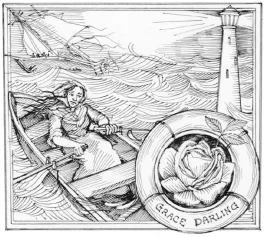I loved my mother, but I couldn’t grant her wish. She longed, she often said, to have a flower named after her.
Flowers and plants named after people are, as we know, numerous. As I wander around my autumn garden putting it to bed, I see many shrubs that soon will be bare brown lumps, less distinguishable than the botanists that bear their names: Clark Abel, William Forsyth, Johan Van der Deutz, and Charles von Weigel are all remembered here, but their namesakes will be more or less anonymous for the next few months. At least the Kalmia (mountain laurel) will stay green. It commemorates the Swedish botanist Peter Kalm, who accompanied Linnaeus to Russia and was loved by him “as was his own child.”
Linnaeus didn’t always respect those to whom he gave plant names. He named Gronovia for the ambitious botanist Gronovius, “being a climbing plant which grasps all other plants.” And he named the day flower Commelina because it has three petals, two large and one small, and there were three Commelin brothers—two prominent botanists and one who died “before achieving anything in Botany”!
Although some names remind us of distinguished persons, others refer to those who would probably otherwise be forgotten. At this time of year, one of the loveliest sights in my autumn garden is the Parrotia persica, a hazel-like tree now covered with brightly hued leaves. No, it’s not named for the brilliantly feathered bird—but for an obscure German botanist, seemingly best remembered for climbing Mount Ararat in 1834!

In spite of her love of gardening, my mother never knew a botanist to give her name to a flower—though many who knew little or nothing of horticulture remain forever in the names of plants. Roses, particularly, were named for wives, mistresses, film stars, and heroes in all walks of life. One example was Grace Darling, who lived with her father in a bleak lighthouse. In 1838 she courageously rowed through huge stormy seas to help rescue shipwrecked sailors. She died young, but left a creamy pink rose named for herself. She herself, as far as I know, had no roses or even a garden of her own.
My mother never gave her name to a flower—nor did she name either of her daughters for one! Naming girls for flowers goes back a long way. Indeed, in Greek mythology, gods and wayward nymphs quite often turned into flowers—Daphne is a common girl’s name still. Other girls were called after well-known flowers, especially those associated with innocence. In the 19th century, particularly popular were names like Daisy, Violet, Lily, and Rose, seeming to Victorian mamas emblems of purity and loveliness. One hopes the young ladies grew up as expected. Other names, used still today, are more sprightly—Poppy, Heather, Holly, and Cherry being just a few.
One name not often found was of the “bumboat” woman in Gilbert and Sullivan’s H.M.S. Pinafore. This lady, always portrayed as large and buxom, was called “Dear Little Buttercup,” although, as she sings, “I could never tell why.” Her abundant curves (and a certain amount of intrigue) eventually win her the captain of the ship!
Yes, flowery names can definitely give the wrong impression. Indeed, I know two odiferous dogs called Lily and Rosie. I know a canine Holly and a canine Poppy. There are pooches called Jasmine, Daisy, Dalia, and Iris among the flower names—though, in truth, I can never tell why!
Not all young girls, either, had a history as fair as their namesakes. In the Middle East, Tamar is a popular name for girls. It comes from tamr, the Arabic for “date.” The date in that culture was not only essential to life, providing food and shelter, but revered for its graceful palms. It was often a suitable name for a lovely young girl. Not all their lives reflected it. Tamar, Absalom’s “fair sister,” was helplessly embroiled in a story worthy of the most sordid news we read today, including incest, rape, and murder. (The curious can read all about it in II Samuel 13.) Poor little Gelsomina (Jasmine) in La Strada had a sad story, too. And Rosamund (for Rosamundi, or “Rose of the World”) was, the leg-end tells us, hunted down by Eleanor, the jealous wife of Henry II, and murdered. Legend or not, we know she died young and her tomb bore the epitaph that she did not now smell like a rose (non redolet sed olet). The rose called for her is, however, pink and white and deliciously fragrant.
In the autumn, we often think of those who are no longer with us. It’s that time of year. Life will continue, but much is dying away. It’s time to let the garden die, too—or at least go to sleep until next spring. We gardeners are lucky because, having learned this year what not to do, we’ll have another chance to change things. Sadly, we can’t always do that with our own lives—and we sometimes wish we could go back and give more to those we loved. At least I could have been more sympathetic when my mother wished to be remembered in a flower. I just didn’t see why she would have wanted that! And I cannot give her the wish unless I breed a new flower (that’s unlikely). I can do no more than remember the flowers she grew so lovingly. Perhaps that might be enough for most gardeners in the end. ❖


 Previous
Previous

